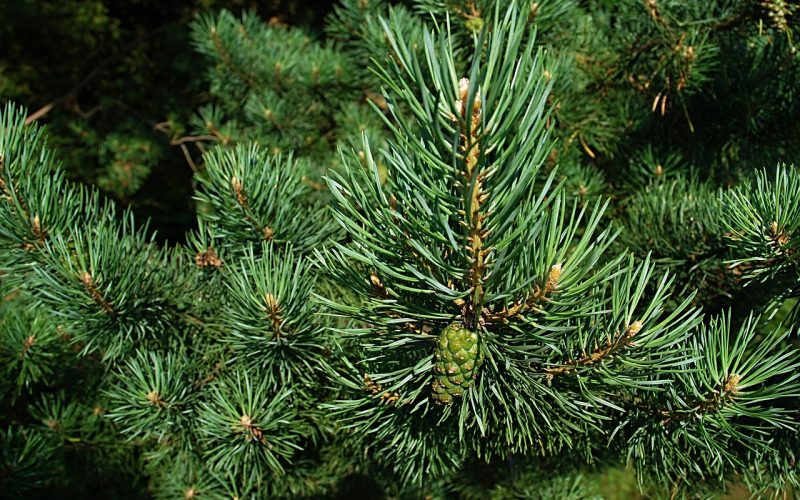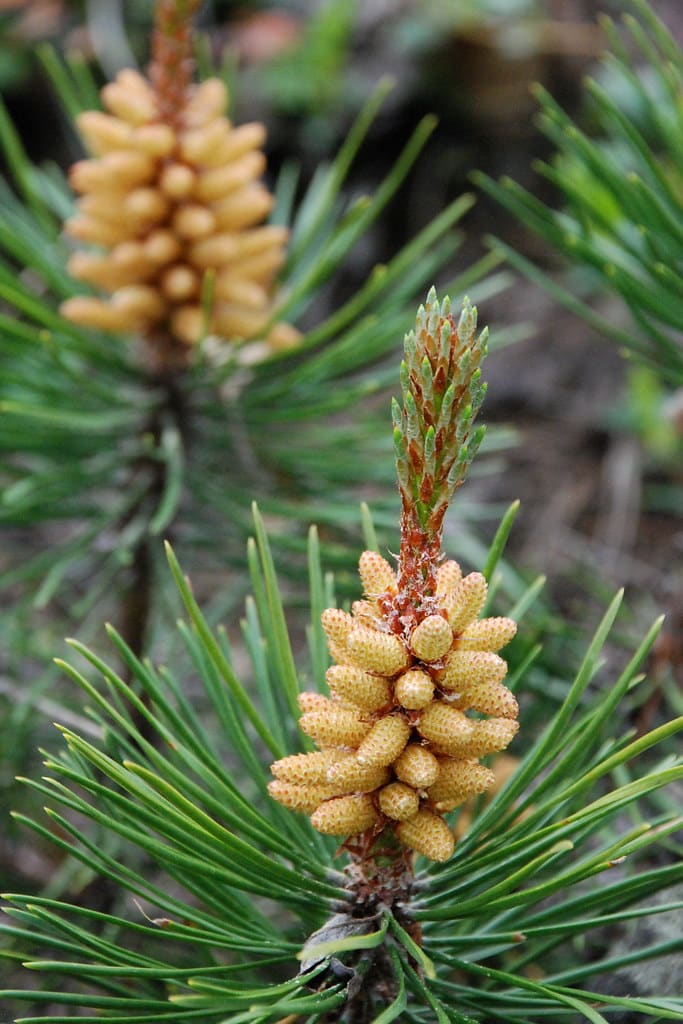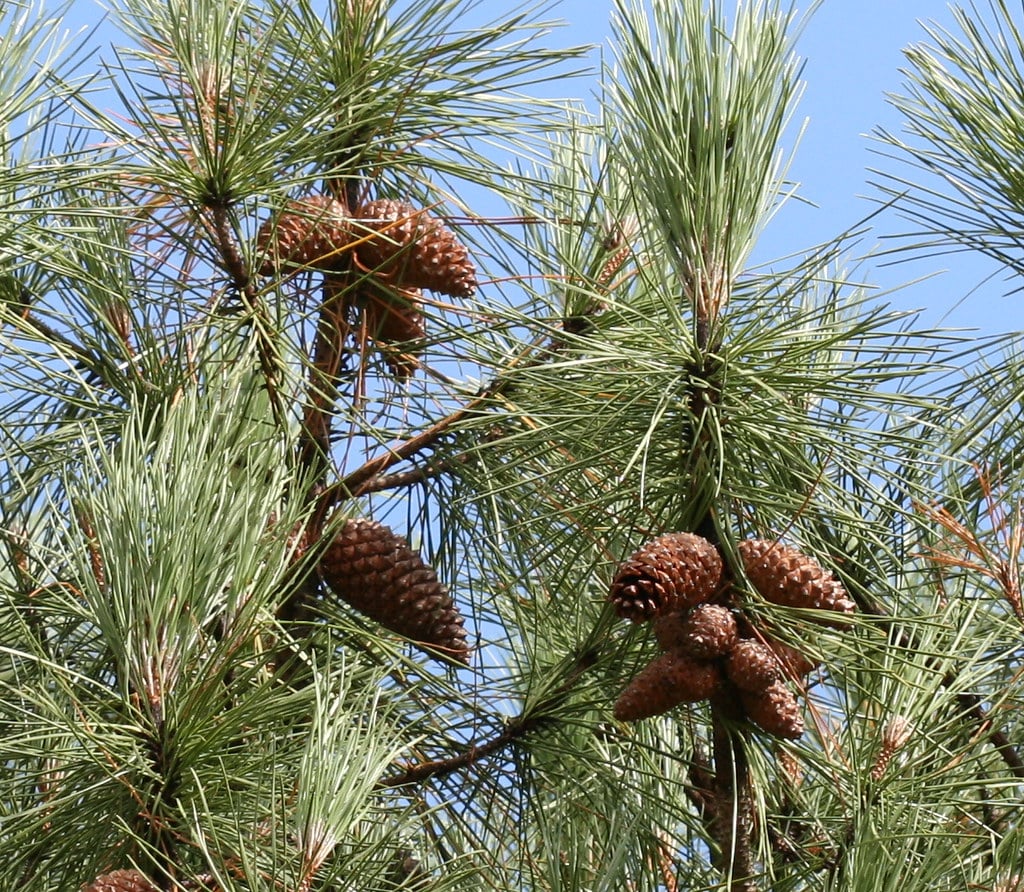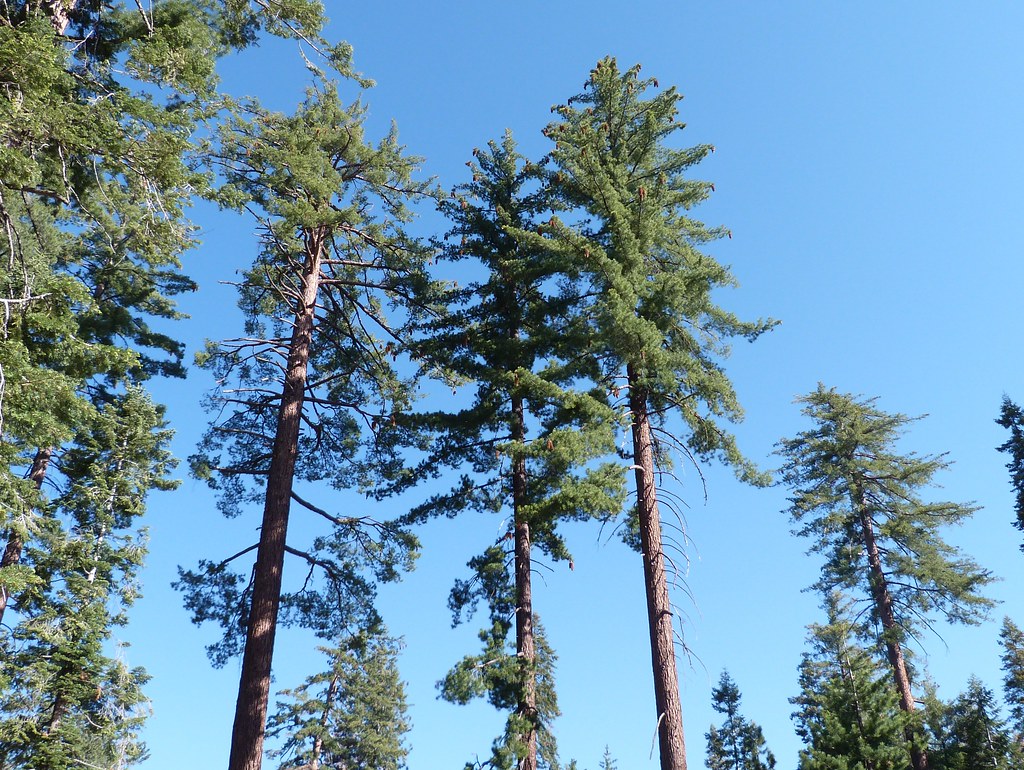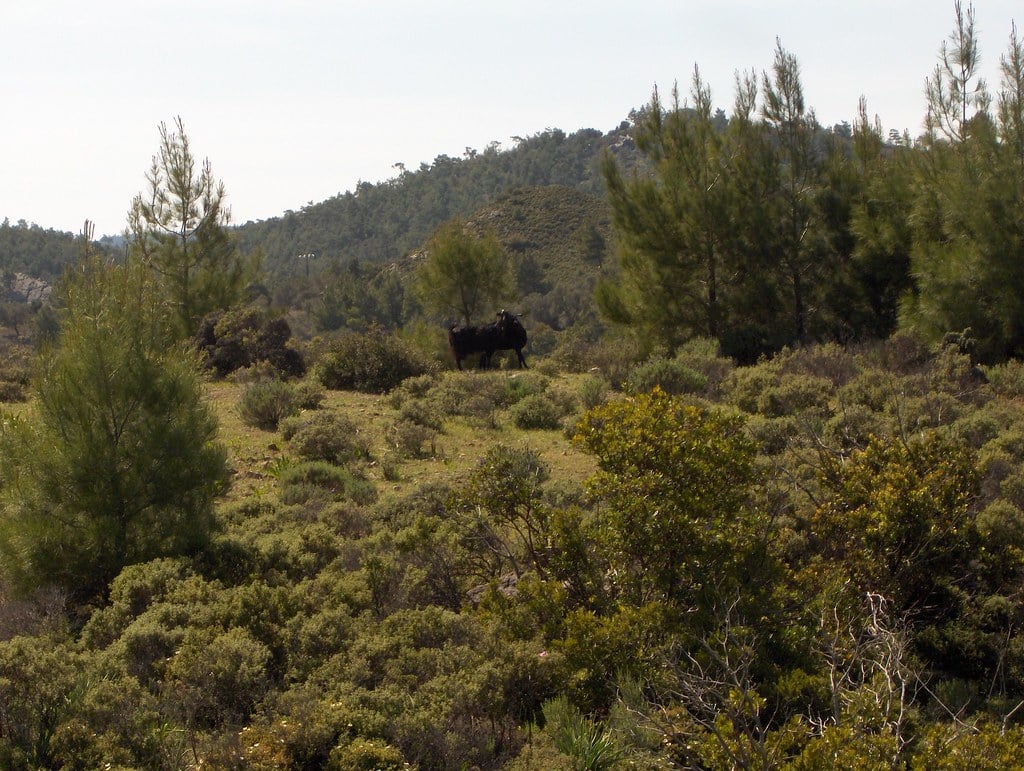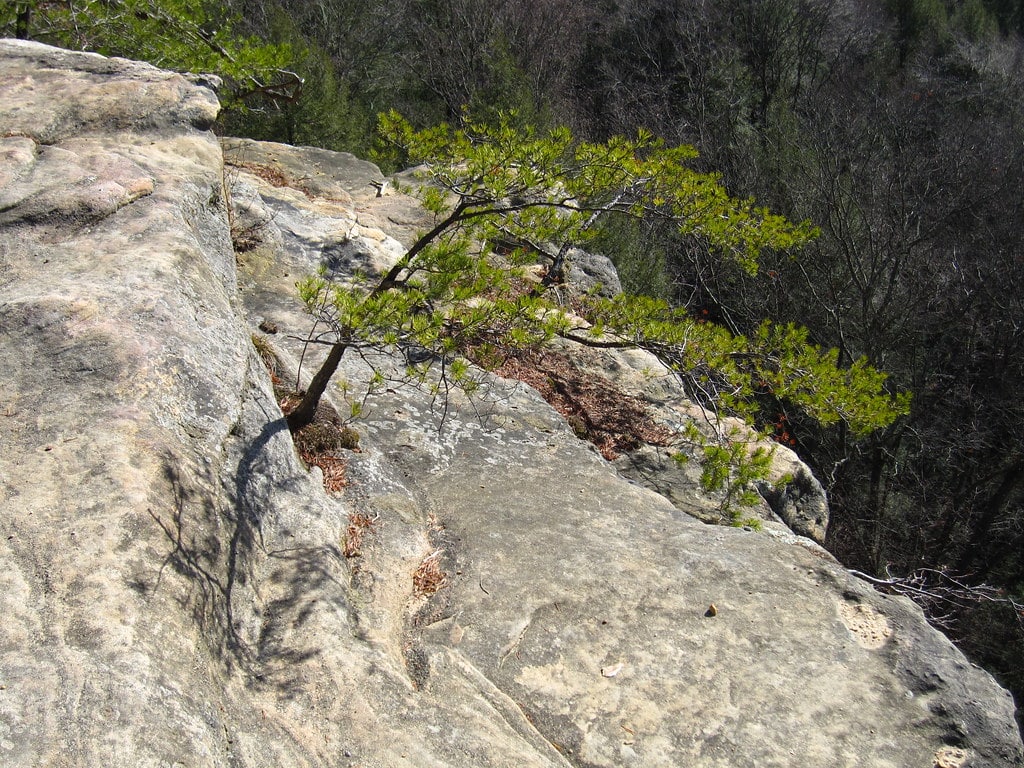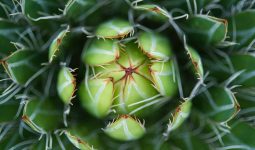Pine trees are evergreen coniferous trees that can be found all around the world in a variety of climates.
With over 100 species, these different types of pine trees have many different shapes and sizes.
Each type of pine tree has its distinct characteristics. In our blog post, we will explore the various types of pine trees, their common characteristics, and how to identify them.
Read on!
1. Aleppo Pine

The Aleppo pine is first on our list of different types of pine trees. It is a species of pine native to the Mediterranean region, from Morocco and Portugal in the west to the Sinai Peninsula in the east.
It is also found growing on the island of Cyprus. It is a small to medium-sized evergreen tree growing up to 10-15 meters tall with a trunk diameter of up to 1 meter. Its leaves are needle-like, dark green, 2–5 cm long, and 1 mm thick.
The Aleppo pine is a very hardy species, surviving temperatures as low as -15 °C.
Its bark is dark gray to brown and is longitudinally fissured. It produces 3–7 cm long cones, which ripen in late summer and contain edible seeds.
The Aleppo pine is widely used in landscaping as it is relatively low maintenance, tolerant of various soils, and resistant to pests and diseases.
It can be grown in urban areas, making it a popular choice for parks, gardens, and other green spaces.
Its timber is also valued for its strength and durability.
The Aleppo pine is also widely cultivated for its edible seeds, which are sometimes used in cooking.
In addition, its needles are used for ornamental purposes and for creating wreaths and bouquets.
2. Austrian Pine
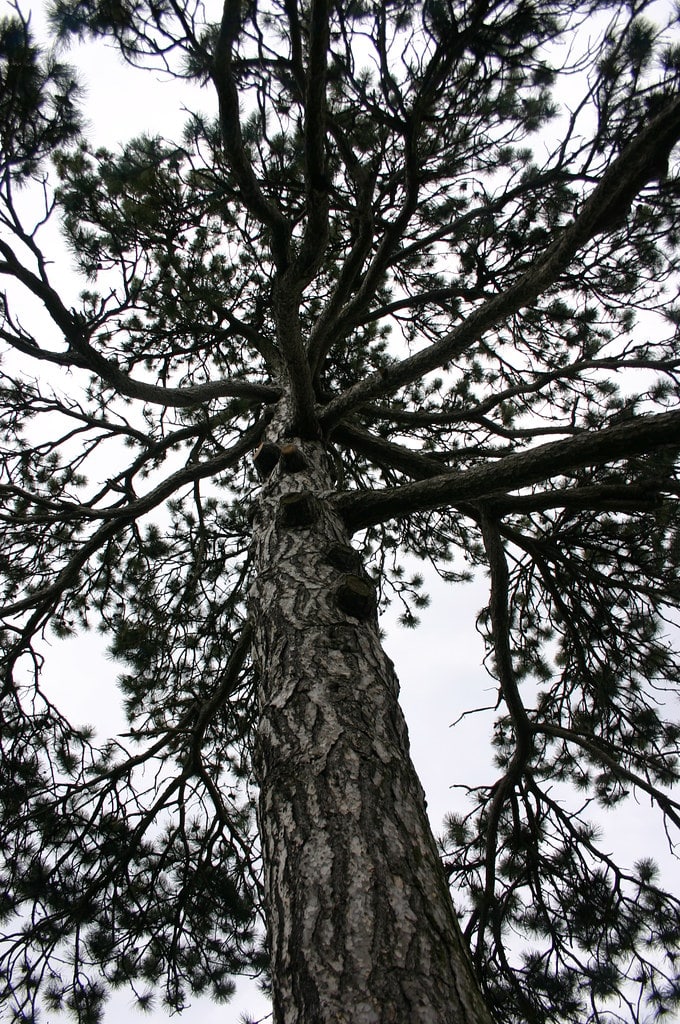
The Austrian Pine is also on our list of different types of pine trees. It’s a coniferous evergreen tree native to Central and Southern Europe.
It is a medium-sized tree, typically reaching 30–60 feet and occasionally up to 100 feet.
The bark is gray to reddish-brown with deep furrows and scaly plates.
The needles are 1.5–4 inches long, blue-green in color, and arranged in pairs on the branches.
The Austrian Pine is one of North America’s most common pine species and can grow in urban areas, parks, and other green spaces.
The Austrian Pine is tolerant of both hot and cold climates, making it an ideal choice for planting in various locations.
This pine tree is also relatively resistant to pests and disease, making it a good choice for landscaping.
However, due to its rapid growth rate, this tree should be pruned regularly to avoid becoming too large or unmanageable.
The Austrian Pine produces small cones containing its seeds, making it an excellent food source for wildlife.
3. Bristlecone Pine
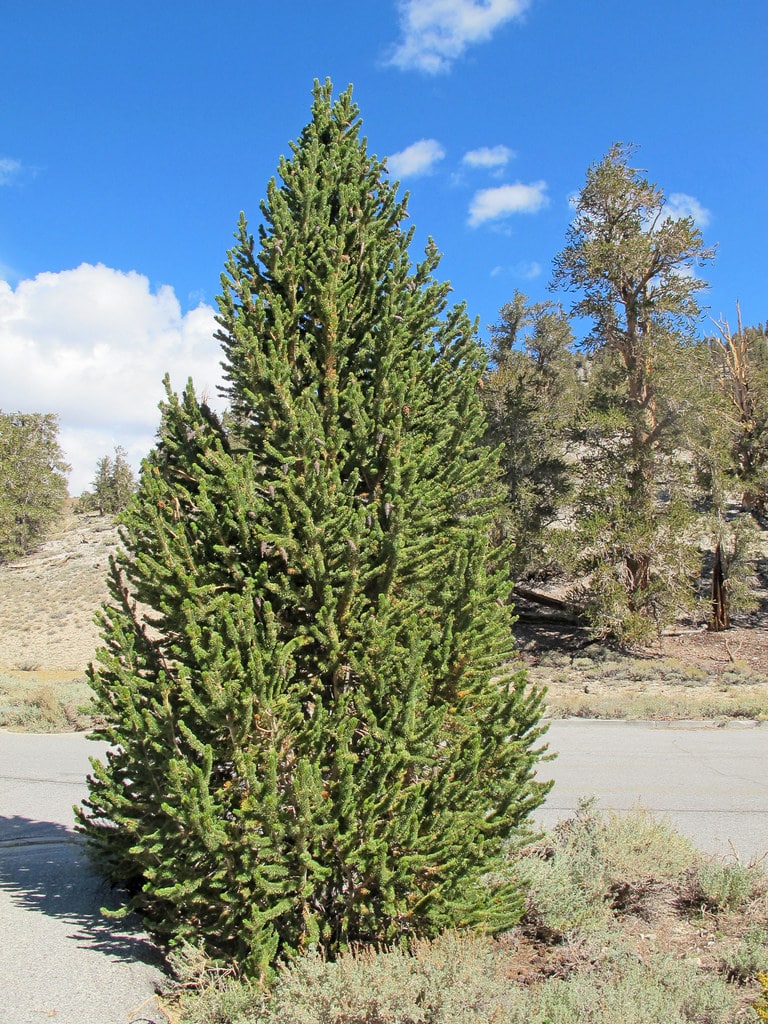
The Bristlecone pine tree is a coniferous tree found in the mountains of North America and Western Europe.
These different types of pine trees are known for their unique bark, which has distinctive ridges, as well as for their slow growth rate and exceptionally long life span.
The wood of the Bristlecone pine tree is also highly dense, making it a popular choice for crafting furniture and musical instruments.
In addition to its various uses, the Bristlecone pine tree is well known for its aesthetic appeal, picturesque shape, and lovely evergreen needles.
The Bristlecone pine tree is highly resistant to environmental stresses, allowing it to thrive in harsh conditions such as dry climates and high altitudes.
It is also a very hardy species, capable of withstanding heavy winds, extreme temperatures, and even severe weather events such as droughts and wildfires.
For these reasons, the Bristlecone pine tree is an excellent choice for landscaping projects in challenging climates and can also be used as an ornamental tree in urban areas.
4. Canary Island Pine

The Canary Island Pine is a large evergreen tree native to the Canary Islands. It has a straight trunk and can grow up to 90 feet tall, with a circumference of 25 feet.
Its leaves are light green and have a needle-like shape. Its bark is gray and scaly, with small horizontal ridges.
This tree is known for its hardiness, resistance to drought, and ability to resist cold temperatures.
In addition, it is often planted as an ornamental tree in parks, gardens, and residential areas.
The wood of the Canary Island Pine is very durable, making it a popular choice for furniture, flooring, and even tools.
It is also used for making boats and ship hulls due to its strength.
Furthermore, it is an excellent fuel source, providing a natural energy source. Additionally, its fragrant scent makes it popular in perfumes and incense.
Overall, the Canary Island Pine is an important species that benefits both people and nature.
5. Chir Pine
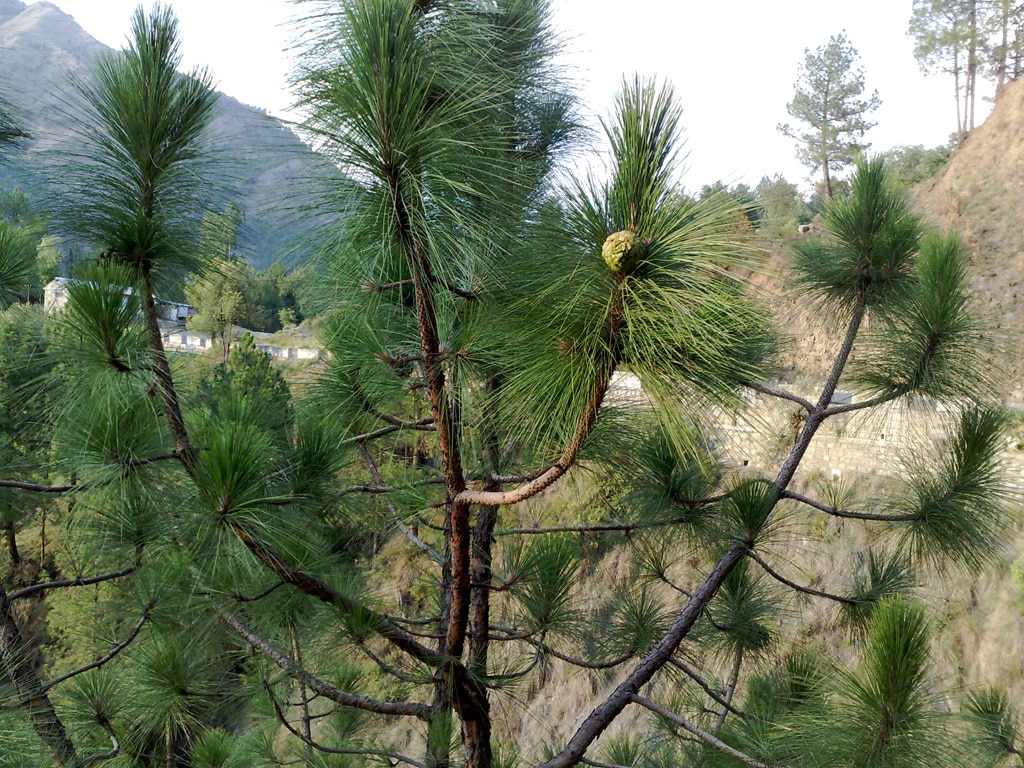
Chir Pine (Pinus roxburghii), also known as Indian Longleaf Pine, is native to India and one of the most important pine tree types in that country.
It is a medium-sized tree with long, yellowish-green needles and large, reddish-brown cones.
Chir Pine is valued for its wood used in construction and furniture-making. The tree is also grown as an ornamental due to its striking appearance.
Chir Pine tolerates a wide range of temperatures and soil types and can withstand drought.
It is an essential source of shade, shelter, and food for wildlife and a great addition to any landscape.
Chir Pine grows best in full sun and prefers slightly acidic soil with good drainage. The tree is easy to transplant and can propagate from seeds and cuttings.
Pruning is essential for maintaining the tree’s shape, as it tends to become lanky if not regularly pruned.
When choosing a site for planting a Chir Pine, choosing an area that won’t be exposed to strong winds is essential.
This tree is vulnerable to insect infestations and fungal diseases, so proper care must be taken to protect it from these threats.
6. Jack Pine
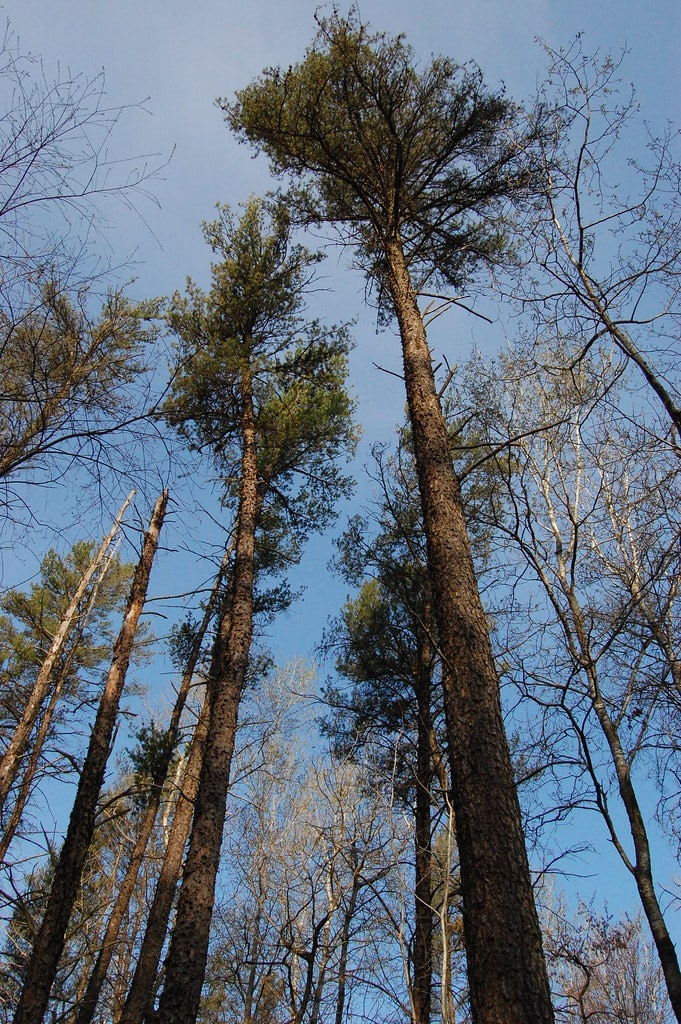
The Jack Pine is next on our list of pine tree types. It is a medium-sized evergreen conifer native to North America.
It grows in dry, sandy soils and rocky areas of the northern United States and southern Canada.
The Jack Pine is pyramidal with reddish-brown bark, needles in two clusters, and small, yellow-brown cones covered with scales.
It is a famous ornamental tree because of its adaptability and ability to tolerate cold temperatures and harsh climates.
This makes it an excellent choice for areas prone to drought and high winds. It is also known to be fire-resistant, which makes it ideal for use in reforestation efforts.
7. Japanese Black Pine
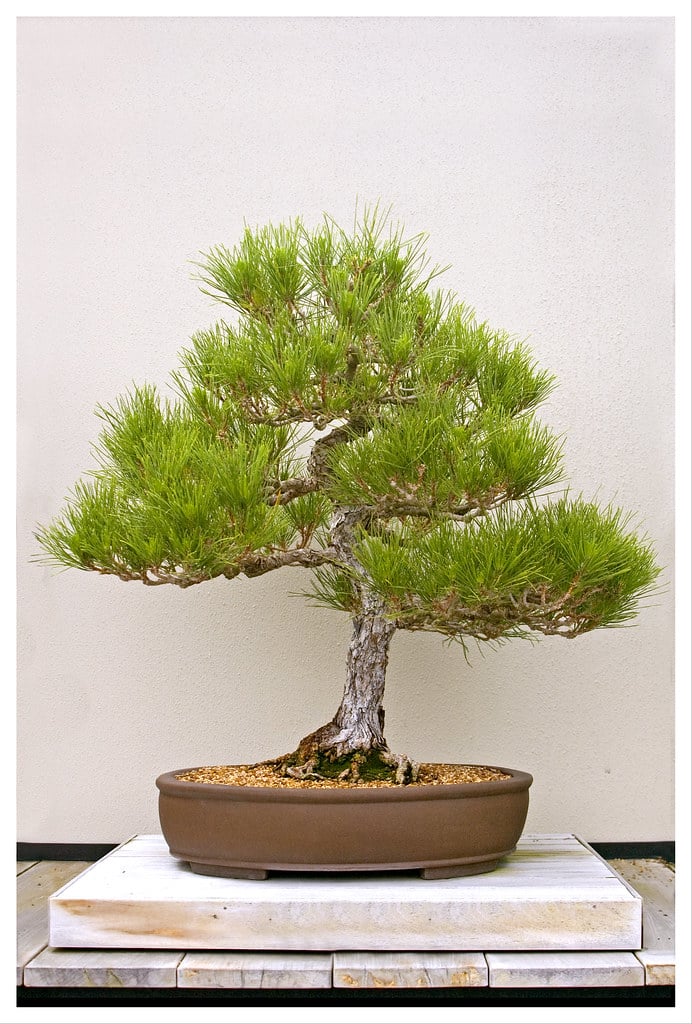
The Japanese Black Pine is native to the coasts of central and southern Japan and the Ryukyu Islands.
It is an evergreen conifer that can reach heights of up to 30 meters with a trunk diameter of 1 meter.
Its leaves are long and narrow, with its needles turning a dark green after a few years. Its bark is rough, scaly, and dark gray to black.
Its cones are large and dark brown, up to 5 centimeters long. This tree is commonly used for its ornamental value in gardens, parks, and streets.
8. Japanese White Pine
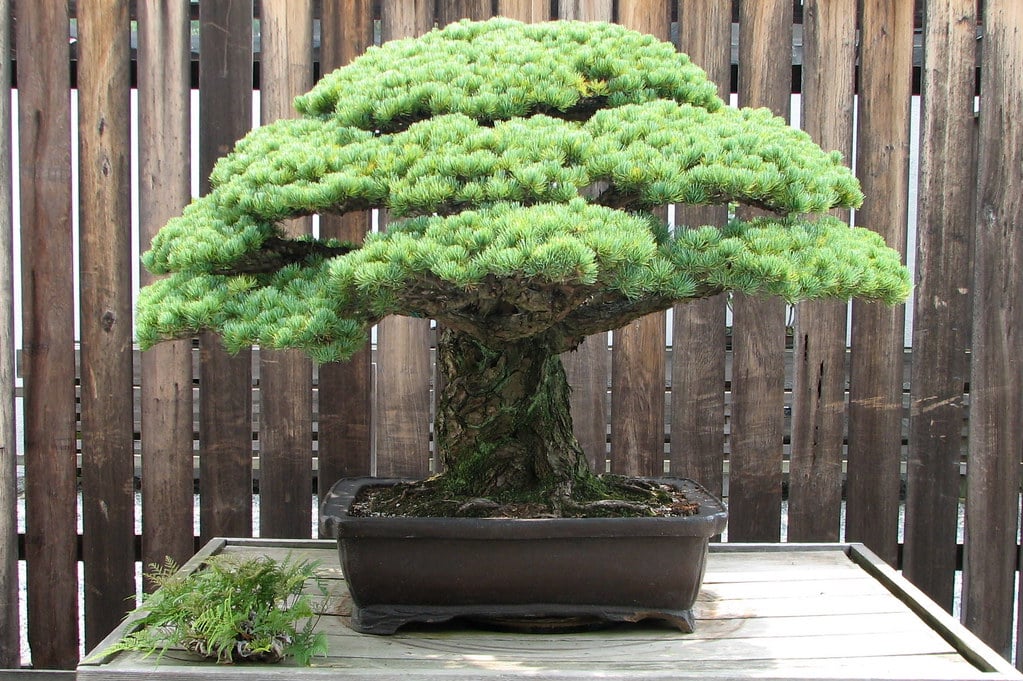
The Japanese White Pine is native to Japan and is a famous ornamental pine tree. It is also known as the ‘Scots Pine’ or ‘Japanese Red Pine.’
It has a broad conical shape, and its needles are short and stiff, which gives it a unique look.
This pine tree can reach heights of up to 80 feet, and its trunk diameter can range from 3 to 6 feet.
The Japanese White Pine is drought tolerant and will thrive in well-drained soils. Its bark is thick and rough, with deep furrows and flaky plates.
Its needle color ranges from bluish-green to yellowish-green, giving it an elegant appearance.
The Japanese White Pine is widely used for bonsai and landscaping due to its attractive features and growth habit.
9. Jeffrey Pine
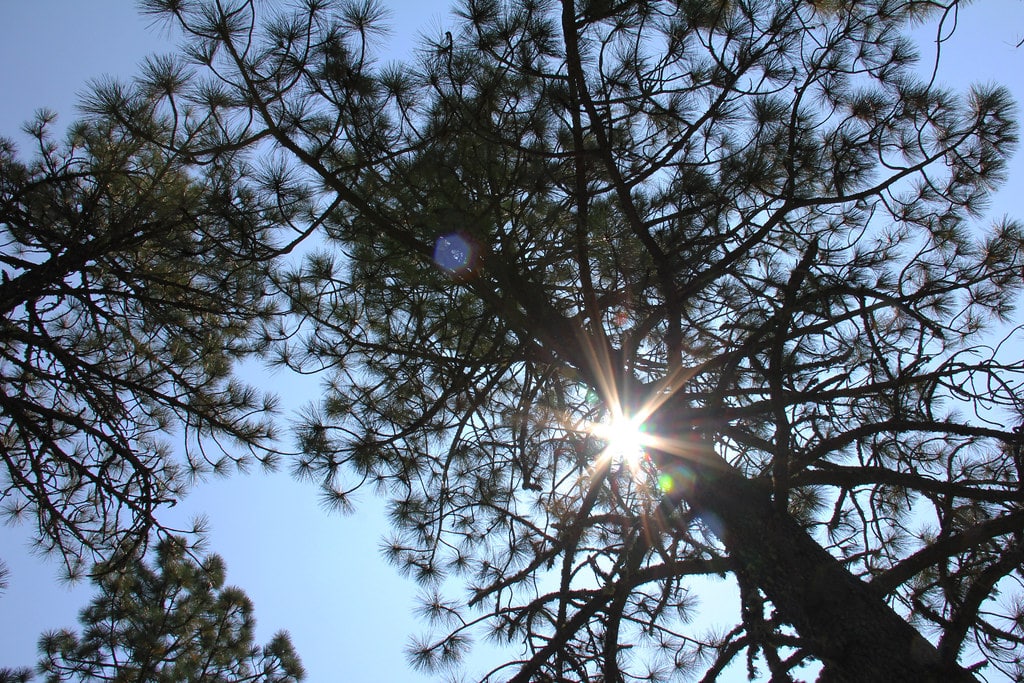
The Jeffrey Pine is a widespread pine tree species native to California, Nevada, Oregon, and some parts of Utah.
These different types of pine trees can grow tall and have a long lifespan, making them ideal for landscaping.
The bark of these different pine tree types is gray and scaly, with the needles typically ranging from light green to bluish-green.
These pine trees prefer direct sunlight and moist, well-drained soil.
Additionally, they are highly resistant to drought and can withstand heat and cold temperatures.
The cones of the Jeffrey Pine are usually about four inches long and are brownish-purple when ripe.
They have a sweet scent and can often be seen hanging from branches.
The Jeffrey Pine is used for several purposes, including lumber, firewood, and timber production.
This species is also known for its fragrant aroma, which makes it a popular choice for those looking to add an attractive feature to their gardens or yards.
The wood of the Jeffrey Pine is light in color and has a straight grain, making it an excellent choice for furniture or cabinets.
It is also sometimes used in flooring or paneling applications.
The Jeffrey Pine is an excellent choice for those seeking an attractive and durable tree with a unique fragrance.
10. Limber Pine
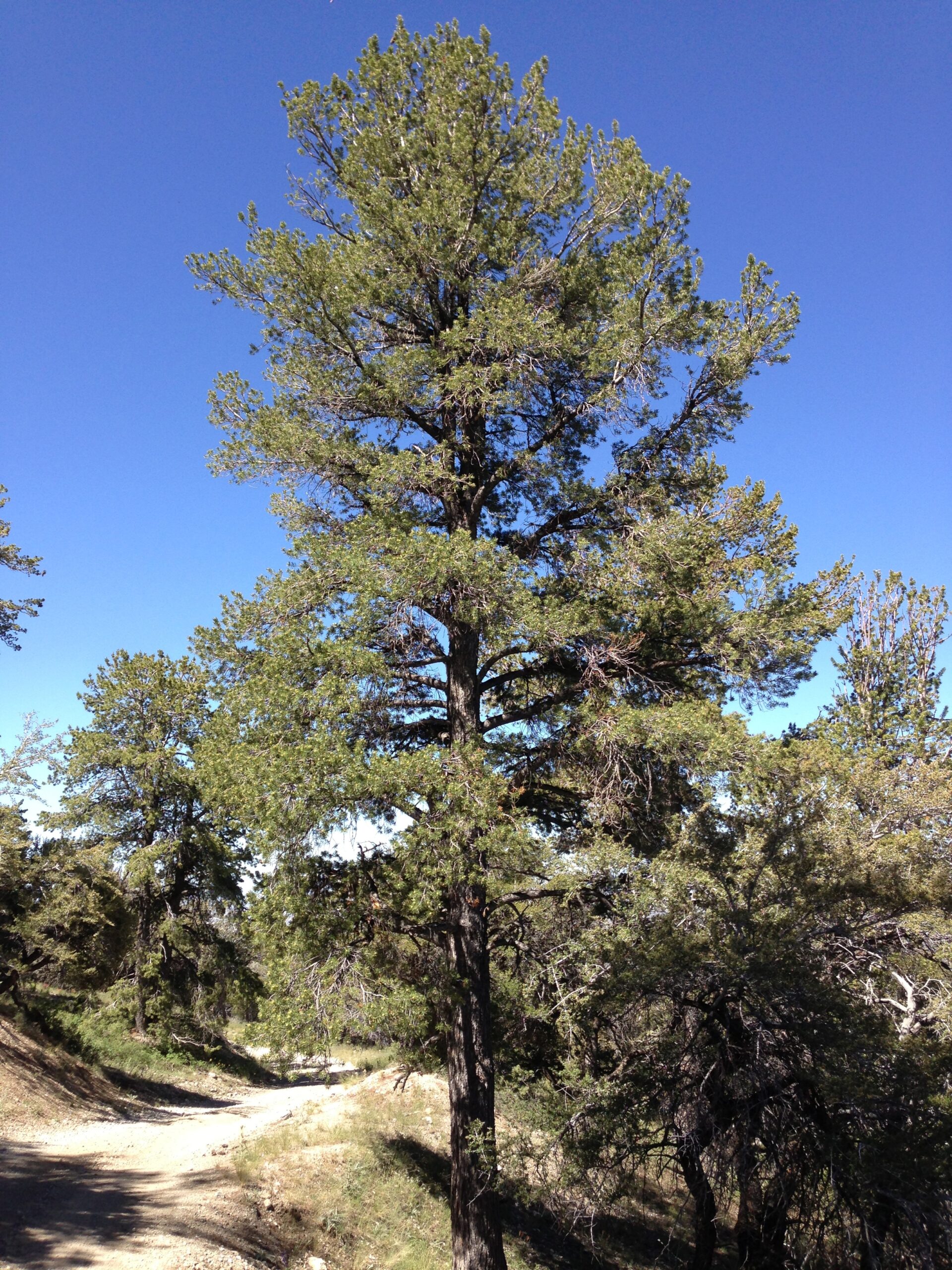
The Limber Pine is a pine species native to mountainous regions in western North America.
It is typically a small to medium-sized tree with a height of up to 20 meters and a trunk diameter of up to 50 cm.
It has a twisted, gnarled growth habit with long needles in five bundles. Its bark is gray-brown with deep fissures.
The Limber Pine is found in high-altitude areas, often near the tree line, where it can withstand harsh climates.
It is drought-tolerant and can thrive on rocky slopes and thin soils. This species of pine produces edible pine nuts prized for their sweet flavor.
11. Loblolly Pine
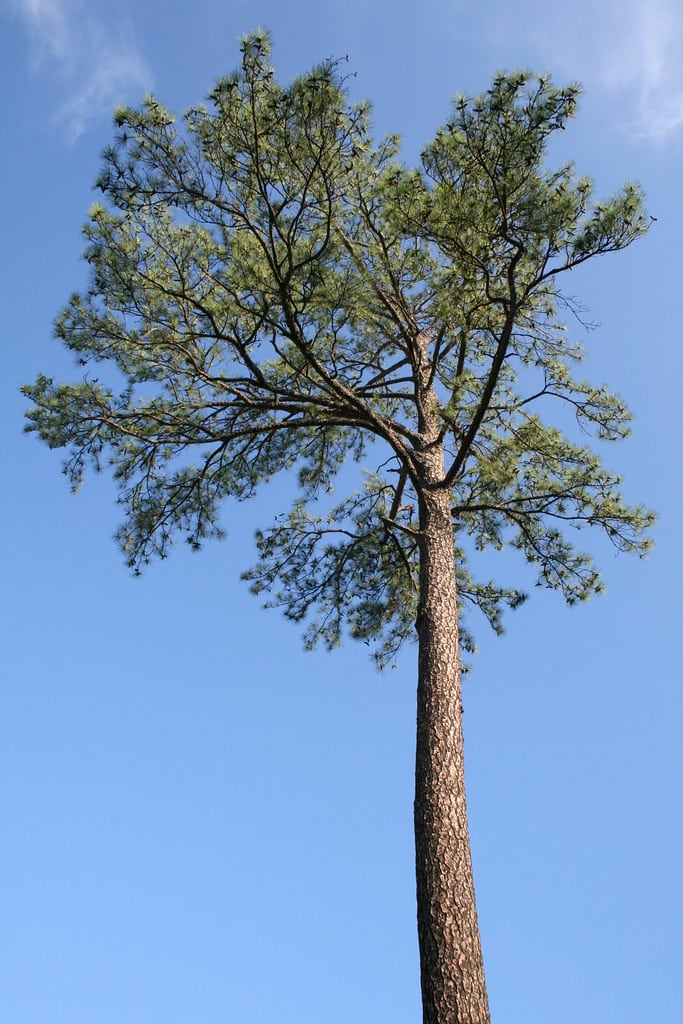
The Loblolly Pine (Pinus taeda) is a pine tree in the southeastern United States.
It is a fast-growing species, capable of reaching heights of up to 100 feet and widths of up to 40 feet.
It has dark green foliage and produces small, yellow-brown cones.
The wood from the Loblolly Pine is a light yellowish color, with a straight grain and moderate density.
This species is often used for lumber, pulpwood, and paper products. It is also famous for landscaping due to its attractive foliage and rapid growth rate.
12. Lodgepole Pine
The Lodgepole Pine is a common conifer found throughout the United States and Canada.
It has a slender, columnar shape and can grow up to 80 feet tall. Its leaves are needles that are bright green and about 2 inches long.
The bark of this tree is smooth and grayish-brown in color. The cones of this tree are small, brown, and cylindrical.
They can stay on the tree branches long before releasing their seeds.
The Lodgepole Pine is an excellent source of timber because it is light, strong, and straight. It is commonly used for fence posts and other building materials.
It is also used for firewood and charcoal production. This pine tree is also important to wildlife because it provides food and shelter for various species.
13. Longleaf Pine
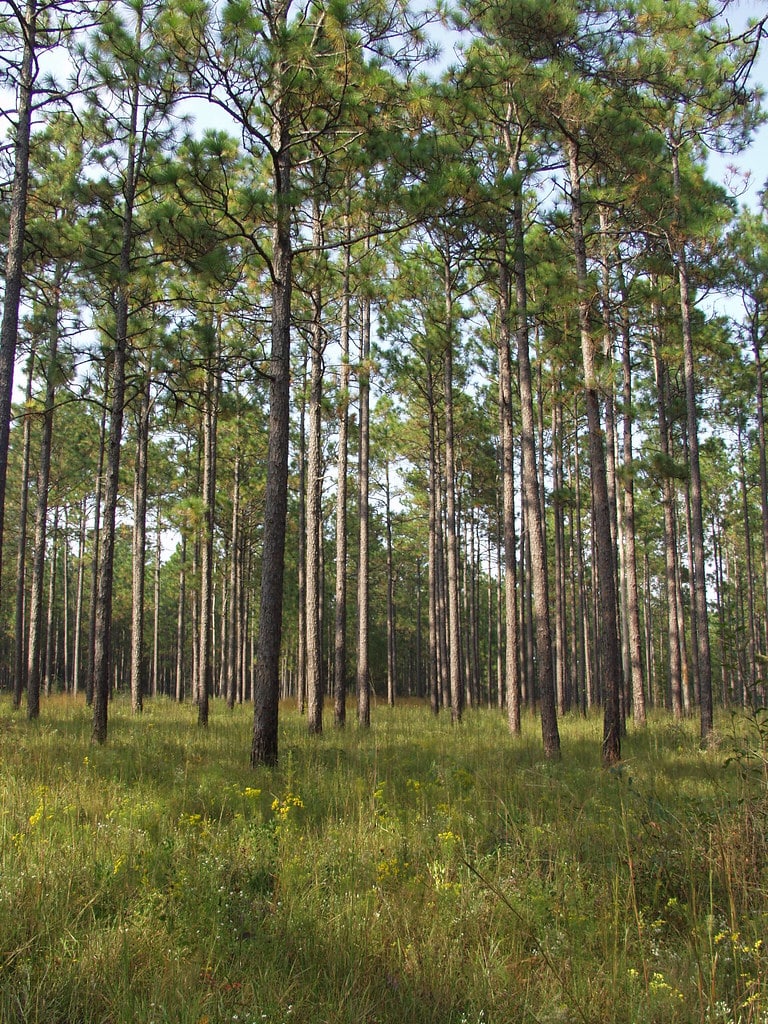
The longleaf pine is an evergreen coniferous tree species that grows in the southeastern United States.
It is one of the largest different types of pine trees and can grow up to 80 feet tall with a trunk diameter of up to 6 feet.
The needles are long, up to 17 inches, and twisted and form tufts at the ends of branches. The bark is thick, scaly, and reddish-brown.
The longleaf pine produces an edible nut called a “pine cone,” which can be eaten raw or roasted.
Longleaf pines are used in landscaping and timber production. They provide valuable habitats for many bird species as well as other wildlife.
Longleaf different types of pine trees require full sun and well-drained soil to thrive.
They are slow-growing and can take up to 30 years to reach maturity.
They are drought-tolerant and can survive heat, humidity, and drought once established. They require minimal maintenance and can tolerate infrequent pruning.
Longleaf different types of pine trees can live for centuries and have been known to live for up to 600 years.
The longleaf pine is an excellent choice for those looking for a tree that will last for generations.
14. Luchu Pine
The Luchu Pine, native to China and Japan, is a medium-sized tree with reddish-brown bark. It grows in tropical and subtropical regions at altitudes of up to 3,000 feet.
The needles are long and slender with a distinctive, twisted appearance. The cones are large and cone-shaped, and the seeds are edible.
This pine tree is also prized for its wood, which is used for timber and furniture. Its low-maintenance nature makes it a popular choice for landscaping.
15. Maritime Pine
Maritime Pine (Pinus pinaster) is a species of pine native to the Mediterranean region.
It has a dense, rounded canopy with needles 3-5 cm in length and a smooth, grey bark.
The trunk can grow up to 1.2m in diameter, and the tree can reach heights up to 25m.
Maritime Pine is an excellent choice for coastal landscapes due to its tolerance to wind and salt spray, making it suitable for erosion control and landscaping near the coast.
Its ability to grow in poor soil conditions makes it suitable for planting on steep slopes or in areas disturbed by human activities.
Maritime Pine produces a large amount of resin, which can be used to produce turpentine and rosin.
Its wood is commonly used for construction, pulp production, and fuel.
The seeds of Maritime different types of pine trees are edible and high in fatty acids, making them a great source of nutrition.
They are also used in herbal medicine as they contain anti-inflammatory compounds.
16. Mexican Weeping Pine
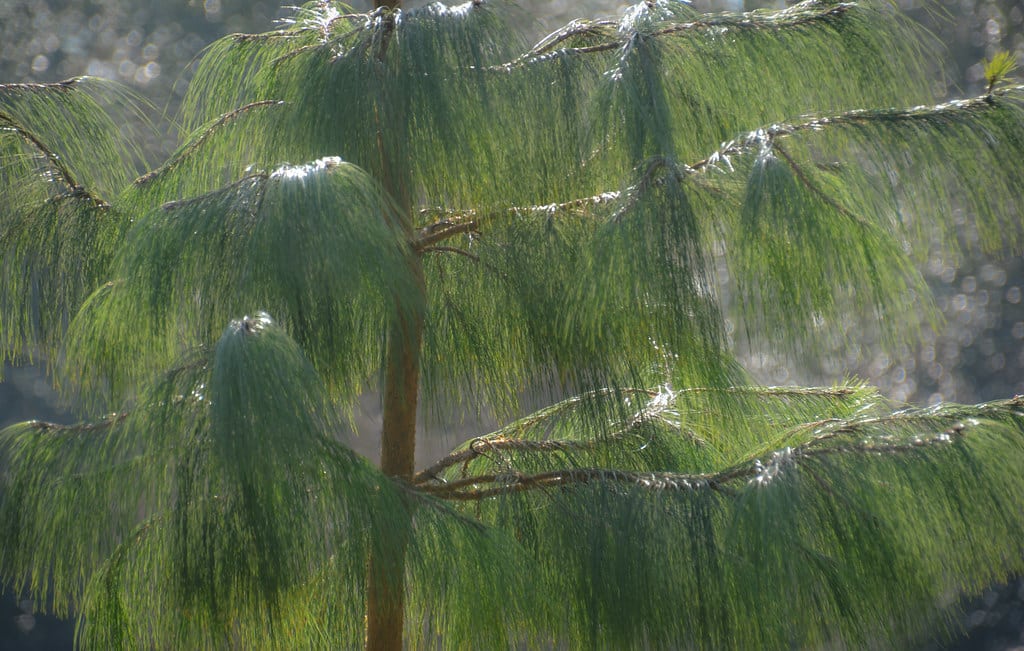
The Mexican Weeping Pine is a large evergreen coniferous tree native to western Mexico. It has a pyramidal shape and can reach up to 30 meters in height.
The needles are short, blue-green, and have a silvery-white underside. The cones are also long, brown, and oblong-shaped.
This tree is very drought-tolerant and will do well in hot, dry climates. It is often used for landscaping or as an ornamental feature in parks or gardens.
The Mexican Weeping Pine is a relatively fast-growing pine tree with the capability of growing up to 3 feet per year.
Its growth rate slows down after maturity, but can still live up to 200 years old.
This tree requires total sun exposure and well-drained soil, but it is pretty hard regarding other environmental conditions.
It is also resistant to pests and diseases, making it an ideal choice for landscape use.
17. Monterey Pine
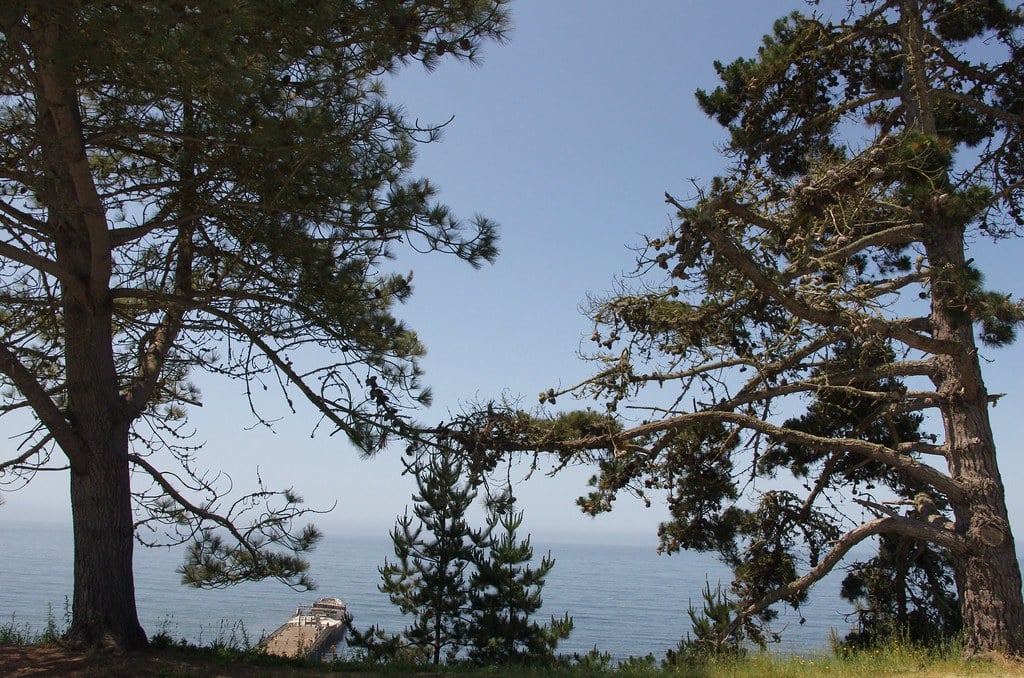
The Monterey Pine, also known as Pinus radiata, is a pine tree native to the Central Coast of California.
It is one of the most widely planted pine different types of pine trees in the world and is well-known for its excellent wood quality.
The Monterey Pine is usually a medium-sized tree with a dense, conical crown and thin, reddish-brown bark.
Its needles are dark green on top and blue-green underneath, typically in bundles of three.
This pine tree is tolerant of various soil types and climate conditions and is widely cultivated.
The Monterey Pine is a fast-growing evergreen often used as an ornamental tree or hedge.
It is also commonly used as a windbreak or erosion control on coastlines, particularly on California’s Pacific Coast.
It has even been used for reforestation in many countries worldwide.
This hardy tree can reach heights of up to 130 feet (40 m), and its dense foliage provides excellent habitat for birds and other wildlife.
It can also provide shelter from harsh weather conditions such as wind and heat.
Overall, the Monterey Pine is an incredibly versatile tree that can be found in many different climates and locations across the globe.
18. Mugo Pine
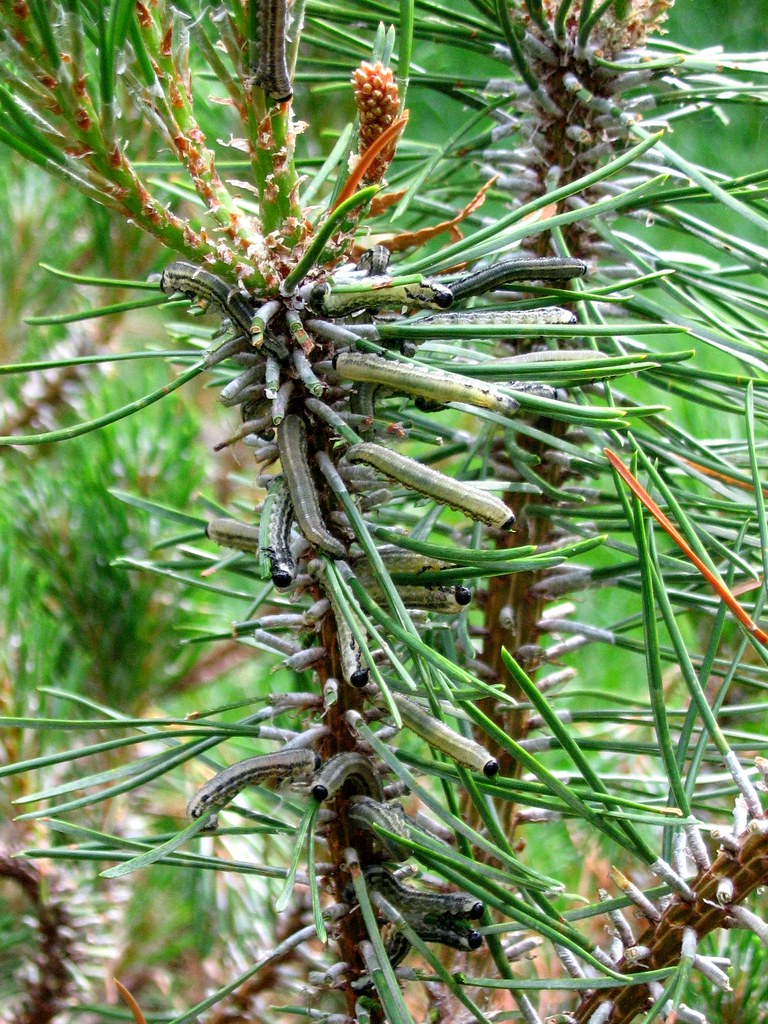
The Mugo Pine is an evergreen conifer native to the mountainous regions of Central and Southern Europe.
It grows in various environments and can be found in areas with temperate climates.
This hardy pine species has needle-like leaves that stay green year-round, making it an attractive choice for landscaping.
Mugo pines are also famous in bonsai displays and make beautiful specimens with their dense, slow-growing branches.
The Mugo Pine is a resilient tree resistant to most pests and diseases. It is also quite tolerant of soil types, from acidic to alkaline.
With proper care, the Mugo different pine tree types can live for many years and add beauty to any garden or yard.
19. Pond Pine
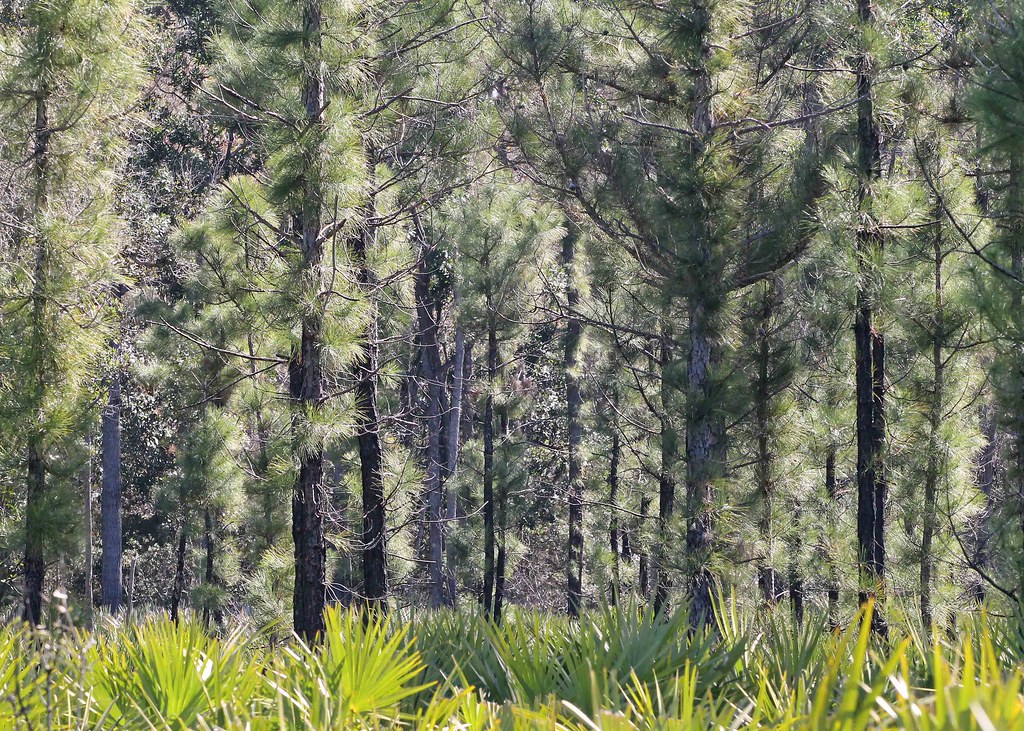
Pond Pine, also known as Pond Cypress, is a cypress native to the southeastern United States.
It grows in areas where water is present and can grow in shallow ponds and wetlands.
Its needles are soft and light green with a glossy sheen and a pyramidal shape. It is an essential tree for providing habitat and food for wildlife in the southeastern US.
Pond Pine is a slow-growing species and can reach heights up to 65 feet, although it is usually much shorter.
Pond pine, one of the different pine tree types, makes an attractive ornamental tree due to its unique shape and foliage.
It is also commonly used as a windbreak or shelterbelt, particularly in agricultural settings.
The wood of Pond Pine is also valuable for lumber, pulp, and fuelwood.
Despite its many benefits, Pond Pine can be difficult to establish due to its slow growth rate and susceptibility to pests and disease.
20. Ponderosa Pine

Ponderosa pine is next on our list of different types of pine trees. It is a coniferous tree species of the Pinaceae family and is native to western North America.
It is also known as western yellow pine and bull pine. The species typically grows from 80 to 100 feet in height and has a wide-spreading crown with stout branches and bright green needles up to 12 inches long. Its bark is usually red-brown, often fissured, and scaly.
Ponderosa pine is one of North America’s most widely planted conifers and makes an attractive ornamental tree for landscapes.
Ponderosa pine is widely adapted to various soil conditions, preferring well-drained soils.
It multiplies in full sunlight and moderate moisture conditions but can also tolerate droughts.
This species can also be planted in acidic or alkaline soils, making it ideal for many landscapes.
It is also used for timber production and is widely used for construction, fuelwood, landscaping, and other purposes.
21. Red Pine
The Red Pine, also known as the Norway Pine, is a typical pine tree native to northern North America, Europe, and Asia.
It has a tall, straight trunk with a broad, open crown of red-brown needles and dangling cones.
The bark is reddish-brown, and the needles are long and slender. It typically grows to 50 to 70 feet but can reach up to 130 feet.
Red Pines have shallow root systems and often grow in large stands or forests, providing habitat for many wildlife species.
22. Sand Pine
Sand pines are evergreen trees that are native to coastal dunes in the southeastern United States.
They are popularly known as sandhills and different types of pine trees and can also be found in Florida and coastal areas of the northern Gulf of Mexico.
Sand different types of pine trees are small, growing up to 40 feet tall, with an irregularly shaped crown.
The bark is thin and reddish-brown and has shallow ridges and furrows. The needles are short, dark green, and can vary in size between 1.5 and 2 inches long.
These needles are also tough and waxy, which helps protect them from the wind and sand.
The sand pine is an extremely hardy species, tolerating poor soils and growing well in sandy areas.
It’s an excellent choice for coastal sites or windbreaks and can also be used to stabilize dunes.
They provide essential habitats for wildlife, including birds, small mammals, and reptiles.
These different types of pine trees are susceptible to attack by the Southern Pine Beetle but are otherwise very resistant to disease and pests.
The sand pine is an excellent choice for a hardy, attractive evergreen tree that will thrive in coastal conditions.
23. Scots Pine
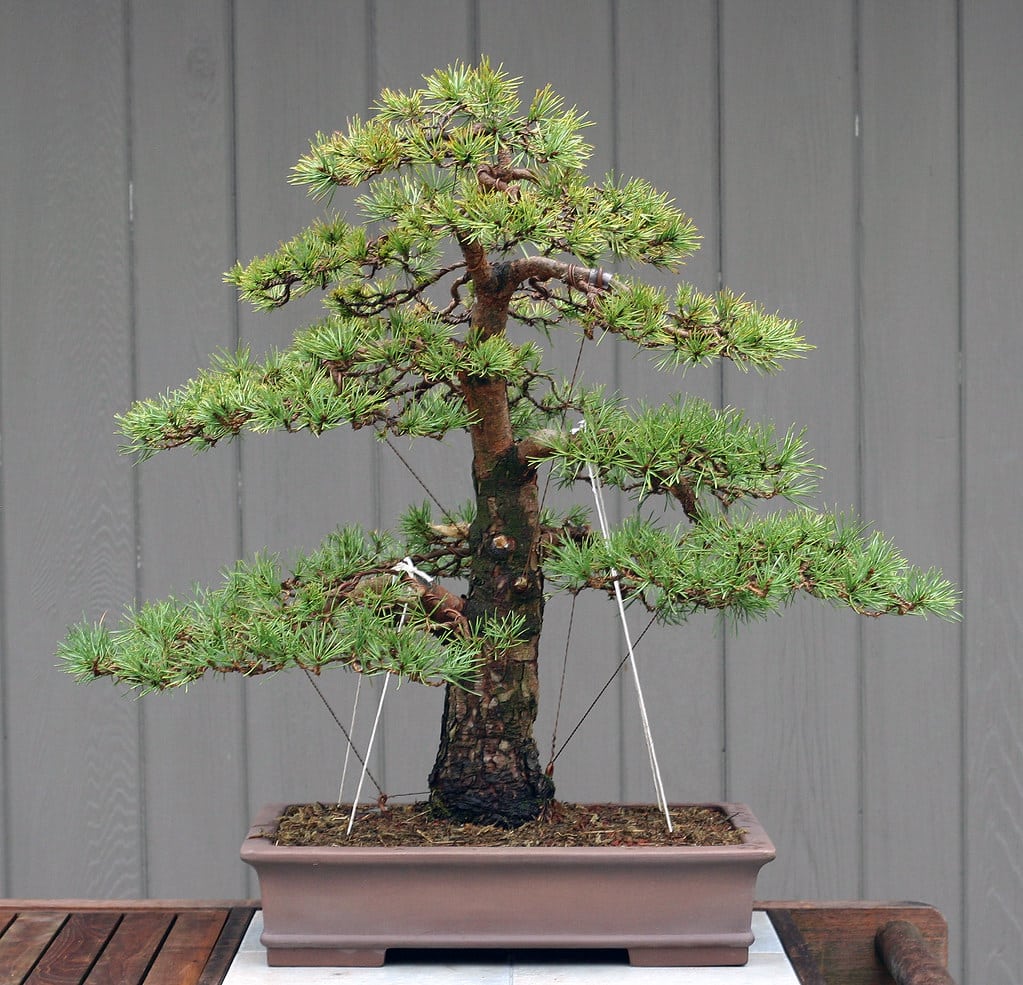
The Scots Pine is a large evergreen coniferous tree native to Scotland and the rest of the British Isles.
It can reach heights of up to 20m, characterized by its upright trunk and branches, dark green needles, and orange-brown bark.
It is often used in landscaping projects and as an ornamental tree due to its attractive foliage and bright red cones.
Its wood is also valued for its strength, durability, and lightweight, making it suitable for furniture and construction materials.
24. Single-Leaf Pinyon Pine
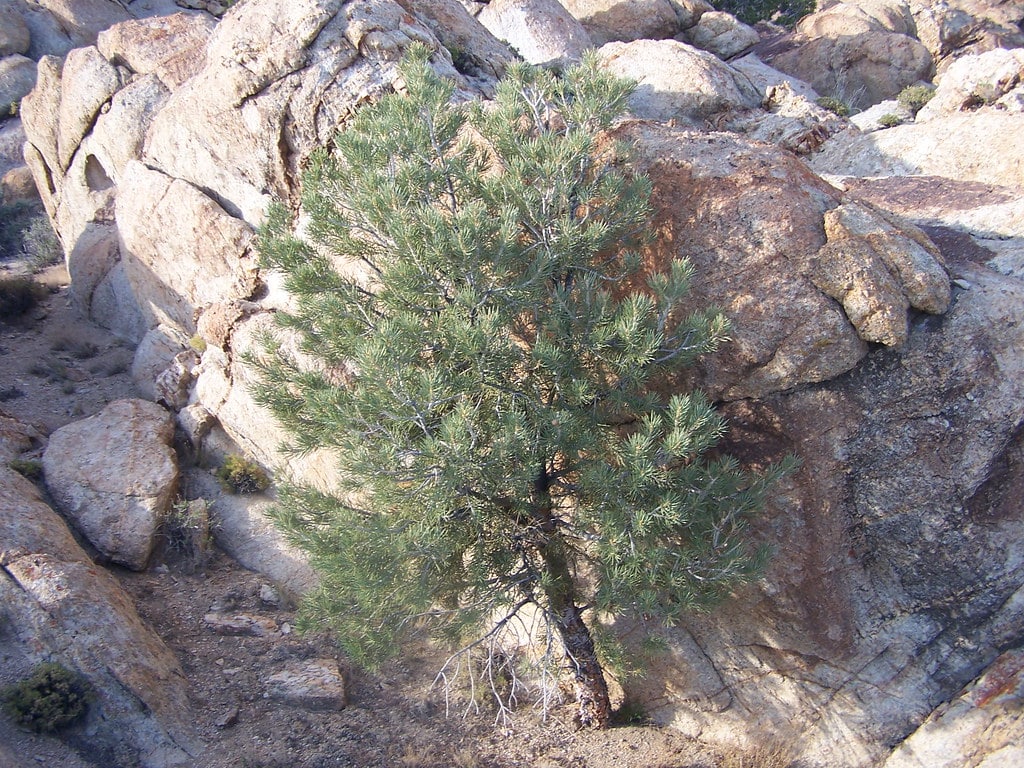
The Monterey Pine is a type of pine tree native to the coastal ranges of central and southern California.
It grows up to 100 feet tall, with a straight trunk and spreading branches. Its bark is reddish-brown and has a thin, scaly texture.
Monterey’s different pine tree types are also known for tolerating wind, salt, and drought.
The Mugo Pine is another pine tree found in Central and Southern Europe.
It is much smaller than the Monterey Pine, usually growing to a maximum height of 20 feet.
It has dark green needles and a round, dense crown of branches. The Mugo Pine is highly tolerant of cold weather and withstands heavy snowfall.
It can also survive in poor soil conditions and is often planted as an ornamental tree in parks and gardens.
25. Sugar Pine
The sugar pine is the largest and tallest of all pine species in North America, reaching heights of up to 200 feet and diameters of 6 feet.
Its long, straight trunk and widespread crown make it stand out among other pines.
This coniferous tree is native to western North America and is known for its yellowish-green needles, which can grow up to 15 inches long.
The sugar pine produces edible seeds, a favorite food for many animals and birds. Its bark is light gray and peels in thin layers.
The sugar pine is also resistant to drought and fire, making it an ideal choice for landscaping and forestry.
In addition to its ornamental appeal, the sugar pine is also highly valued for its timber.
Its wood is incredibly lightweight yet strong, making it perfect for furniture, flooring, and other woodworking projects.
The sap of the sugar pine can be tapped for maple syrup and used for distilling alcoholic beverages.
The lumber from the tree is also used for boatbuilding and cabinetry. The sugar pine is an excellent choice for a majestic and long-lasting tree.
26. Japanese Red Pine

The Japanese Red Pine, also known as Pinus densiflora, is a large evergreen pine tree native to Japan.
It is upright and irregular, with long needles that are soft to the touch.
This pine tree species is prevalent in bonsai culture and can grow up to 30 meters tall in its natural environment. In gardens, it can reach up to 15 meters tall.
It is usually used for ornamental purposes, and its growth rate is slow to moderate.
The Japanese Red Pine is tolerant of many soil types and requires little maintenance.
27. Tenasserim Pine
The Tenasserim Pine is a pine tree found in Southeast Asia and India. It is a medium-sized evergreen with a pyramid-shaped crown and reddish bark.
It grows to a height of up to 30 m and can have branches reaching up to 1 m in diameter.
Its needles are bluish-green and 2-4 cm long. Its cones are cylindrical, 8-20 cm long, and have a hard shell that splits open when ripe.
The Tenasserim different types of pine trees prefer moist, well-drained soils and are often found in lower mountain ranges, where it has been used as a source of timber for many centuries.
28. Torrey Pine
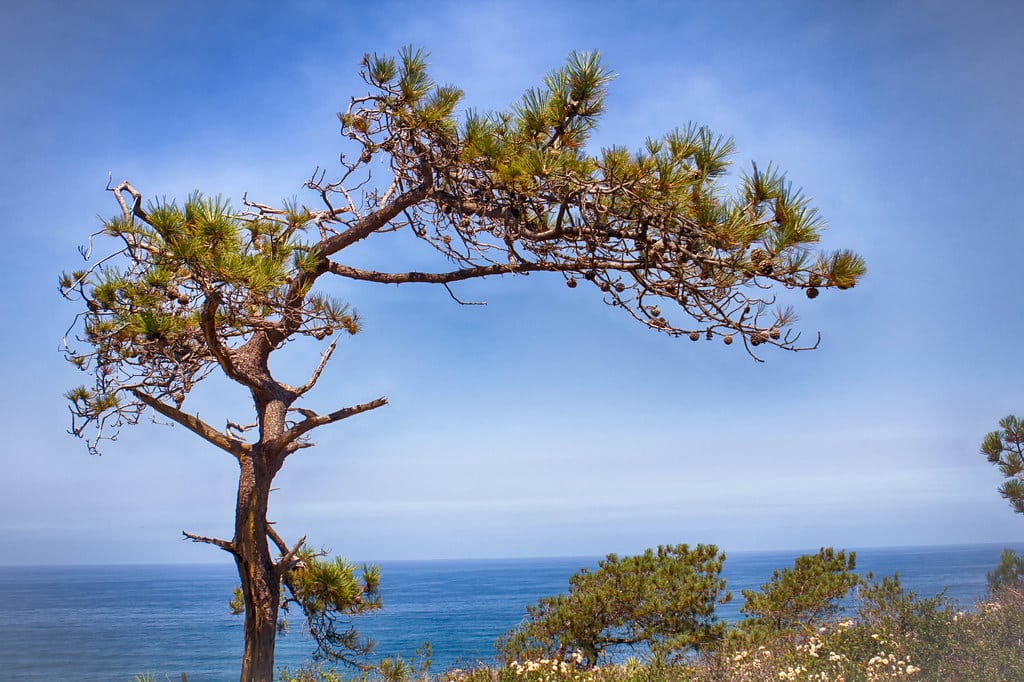
The Torrey Pine is an endangered pine tree species native to the coastal areas of southern California and northern Baja California.
It is one of only two different types of pine tree species endemic to the region and the only species in the genus Pinus torreyana.
The Torrey Pine can reach heights of up to 130 feet, with a thick trunk and wide-spreading branches.
The bark is reddish-brown and deeply furrowed, while the needles are five to eight inches long and range in color from yellow-green to blue-green.
They have small, pointed cones that are usually dark brown or black.
The Torrey Pine is a precious species due to its high levels of endemism and its importance as a habitat for many bird and mammal species.
Unfortunately, its numbers have been significantly reduced due to overgrazing, urbanization, and other threats.
Conservation efforts have been put in place to protect the species, and it has been declared an endangered species in both California and Mexico.
Despite these efforts, the Torrey Pine still faces significant threats, and its future remains uncertain.
29. Turkish Pine
The Turkish Pine (Pinus brutia) is a pine tree native to the Mediterranean region.
It grows in dry, rocky soils and reaches up to 20 meters in height. The leaves are long and slender and feature two needles per bundle.
This species is also known as Calabrian pine or East Mediterranean pine.
Its bark is thick and scaly; its cones are small, greenish-yellow, and develop in clusters of three or four.
This species is highly adaptable and tolerant to drought, salt, and wind.
It has been used for timber production and is valued for its longevity, strength, and lightweight.
30. Two-needle Pinyon Pine
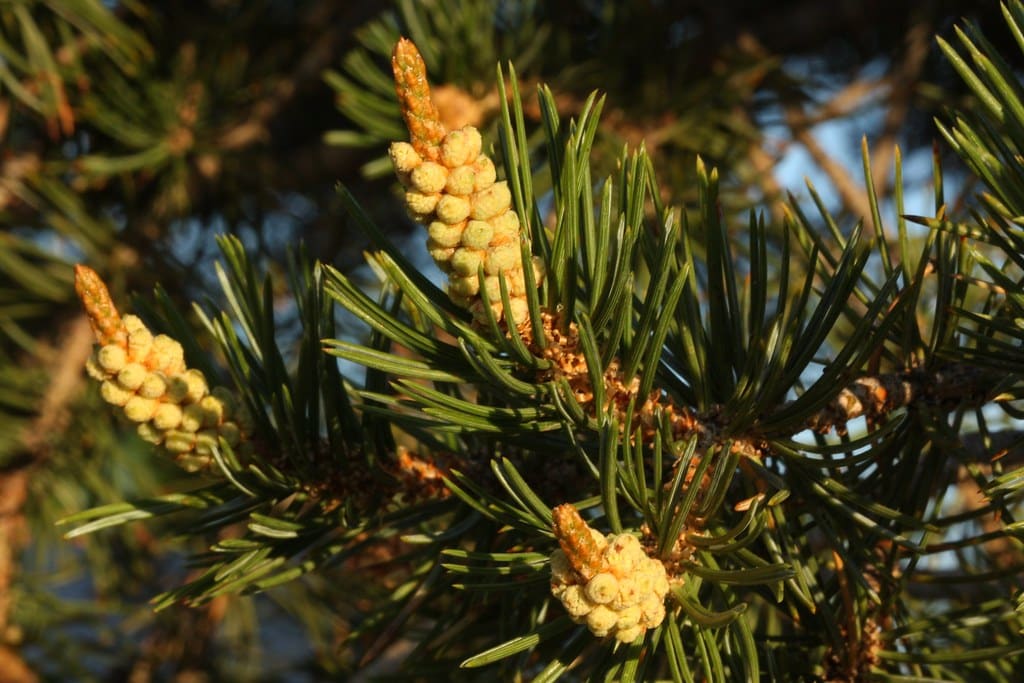
The Two-Needle Pinyon Pine is a small tree native to the Southwestern United States and Northern Mexico.
It is an evergreen with short, two-needled leaves and is considered a low-maintenance pine tree species.
The Two-Needle Pinyon pine trees can be found in many habitats, ranging from arid desert regions to mountain foothills and canyons.
Its bark is usually gray or reddish-brown, and its needles are usually blue-green and sometimes silvery.
The Two-Needle Pinyon Pine is well-adapted to hot climates, as it requires minimal water and does not need regular pruning.
It is also a drought-tolerant species and can withstand prolonged periods without water. This makes it an excellent choice for xeriscaping and desert landscaping.
31. Virginia Pine
The Virginia Pine is a species of pine native to North America. It is also known as the southern yellow pine and is found mostly in the southeastern United States.
The needles are long and dark green and yellow-brown on the underside.
The different types of pine trees grow to heights of up to 100 feet, with a broad, conical crown. Its bark is reddish brown and rough with scaly ridges.
The Virginia Pine is a fast-growing, drought-tolerant tree. Its strong roots make it suitable for planting in areas prone to strong winds and soil erosion.
The Virginia Pine is ideal for landscaping and windbreaks as it is attractive and hardy.
It produces two to five inches long cones and has tiny, glossy seeds that birds love.
32. Western White Pine
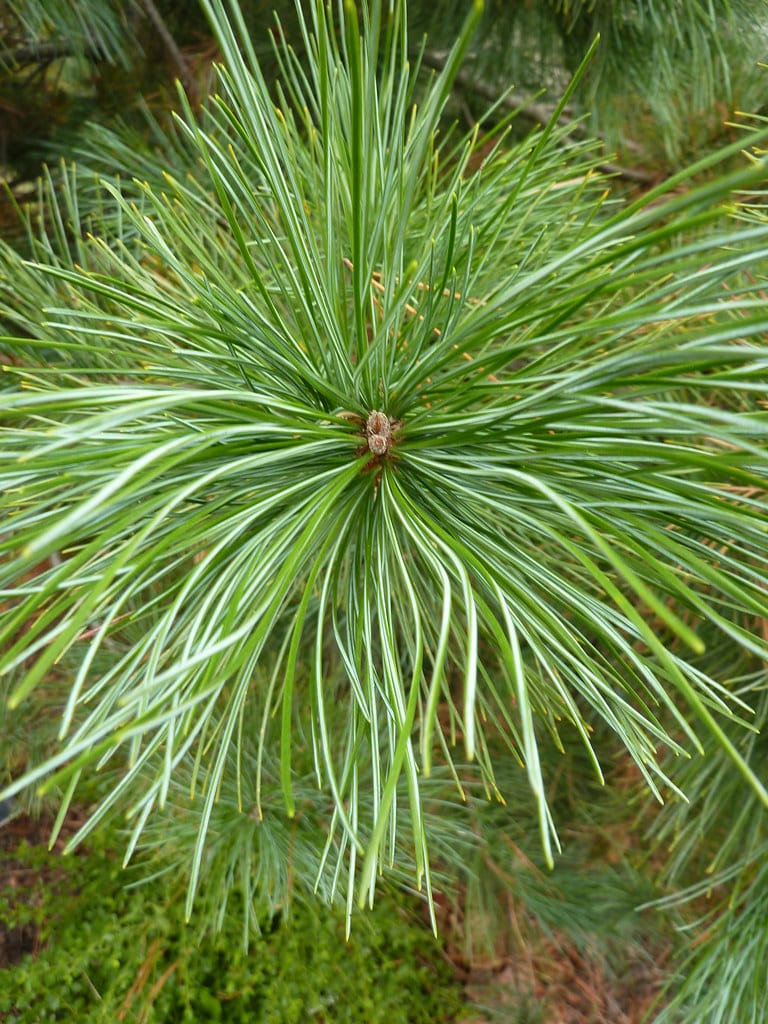
The Western White Pine is native to the western United States, from Washington to California.
This pine tree is well known for its long needles, which can grow up to a foot.
They are also known for their thick bark and bright green hue. They prefer wetter climates so that they can be seen in moist meadows, streams, and rivers.
The Western White Pine is often used for ornamental landscaping due to its tall stature, reaching over 130 feet.
This majestic pine tree also provides a habitat for various birds and animals, making it an essential part of many ecosystems.
33. Whitebark Pine

Lastly, Whitebark Pine (Pinus albicaulis) is a small, conical tree native to the western slopes of the Rocky Mountains in the United States and Canada.
It’s well adapted to high altitudes and severe weather, growing at up to 10,000 feet.
Whitebark Pine is a small but hardy tree, growing up to 40 feet tall. Its bark is reddish-brown with white patches.
The needles are a bright green, turning yellow in fall and staying on the tree for up to 4 years. Its cones are oblong and purple.
Whitebark Pine is an important species to the ecology of its range, as it’s a keystone species providing food and shelter to many birds and mammals. It also helps prevent soil erosion due to its roots stabilizing the soil.
Unfortunately, Whitebark’s different types of pine trees have been severely impacted by climate change and diseases like White Pine Blister Rust, resulting in a drastic decline in its numbers over the last few decades.
Conservation efforts have been ongoing to protect this species and its critical habitat.
Conclusion
Pine different types of pine trees are some of the most iconic and beloved trees in the world, found in many different landscapes across the globe.
Although they all share some common characteristics, hundreds of different types of pine trees vary in shape, size, color, and more.
Our blog post has explored some of the different pine tree types, their key characteristics, and how to identify them.




